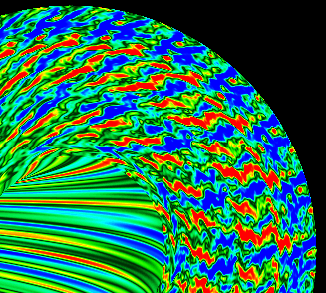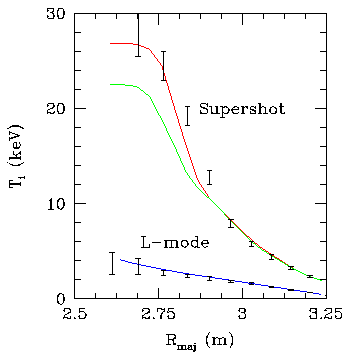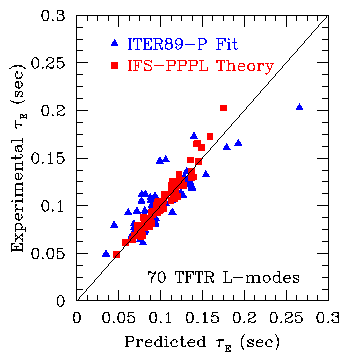Breakthroughs in Understanding Tokamak Plasma Turbulence
In the quest to develop fusion as a practical energy source, one of the
biggest challenges has been to understand and control plasma turbulence.
This turbulence causes hot particles to leak out of the magnetic bottle,
reducing the efficiency of the fusion power plant.
Ways to reduce this
turbulence have recently been found, which could lead to a more
cost-effective fusion reactor design.
 Plasma turbulence is a very complicated problem, and previous theories had
great difficulty in matching actual experiments. The situation was so
confusing that, as recently as a year ago, a report by the National
Research Council ("Plasma Science", 1995, p. 145) stated:
Plasma turbulence is a very complicated problem, and previous theories had
great difficulty in matching actual experiments. The situation was so
confusing that, as recently as a year ago, a report by the National
Research Council ("Plasma Science", 1995, p. 145) stated:
``We have no first-principles understanding of turbulence in
any plasma, and understanding such turbulent behavior is perhaps
the key unsolved problem in plasma physics''
However, we believe that this statement is now out of date, that because of
recent breakthroughs we are now able to predict the turbulence levels in at
least the main core region of many tokamak plasmas. Much more work is
needed to develop a complete turbulent transport model (which includes the
edge region as well, and a broader range of plasma conditions including
sheared flows and particle transport), but the present level of agreement,
as illustrated below, is quite encouraging.
Comparison of the IFS-PPPL Transport Model With TFTR Experiments

IFS-PPPL transport model compared with an L-mode and a Supershot in
TFTR. The simulations (solid lines) capture much of the enormous variation
in the ion temperature between Supershots and L-modes.
[From Dorland and Kotschenreuther]
Caveats: The red and green curves are for different impurity profile
assumptions. The measured temperature at r/a=~0.8 (about R_maj = 3.15 m)
is used as a boundary condition to predict the interior temperature
profile. The colder edge region is not yet fully understood. Also, the
measured convective component of the heat flow is used, which is actually
dominant in the core of the supershot. Nevertheless, the fact that this
model reproduces the dramatic change in the conduction component of the
heat flow is a major step forward, particularly since this model contains
no adjustable parameters to fit to experiments.
Breakthrough in Turbulence Simulations:
IFS-PPPL theory agrees with TFTR better than empirical fit

The IFS-PPPL transport model predicts the global confinement time
for a wide range of L-mode better than a widely used empirical scaling
(ITER-89P).
This is made possible by recent breakthrough in our theoretical
understanding of this plasma turbulence and our ability to simulate it with
advanced supercomputers. We have developed a transport theory based on
nonlinear, 3-D gyrofluid simulations of tokamak turbulence and on
comprehensive linear gyrokinetic stability calculations. This is a
"first-principles" theory in which there are no adjustable parameters which
are fit to experiments.
A complete description of this work, and its caveats, can be found in:
Background: Fusion Energy and Turbulence
Fusion energy research has made significant scientific progress over the
years, as demonstrated by the recent (1994) production of 10 Megawatts of
fusion power in the Tokamak Fusion Test Reactor (TFTR) at Princeton. One of
the main scientific challenges of fusion research is the problem of
small-scale plasma turbulence, which appears to control the quality of the
thermal insulation provided by the confining magnetic field. Understanding
and controlling this turbulence would help improve the economic
attractiveness of future fusion power plants. Plasma turbulence has been a
very challenging scientific problem, as it involves the complex, nonlinear,
3-dimensional, and chaotic physics of interactions between particles and
electromagnetic waves. To date, few quantitative features of plasma
turbulence have been elucidated analytically; certainly, despite
considerable scientific effort, a fundamental theory of turbulence does not
yet exist.
More background info at the
Fusion Energy Educational Web Site
Recent Progress in Gyrofluid Turbulence Simulations
In our work, we have combined innovative physical models and supercomputer
simulations to tackle this problem. We have developed "gyro-Landau fluid"
equations to model kinetic effects (such as parallel and toroidal drift
resonances and associated Landau damping) (cite Beer's thesis, and papers
by Hammett, Waltz, Dorland, Smith, et.al.) which play important roles in
plasma turbulence. We solve these equations using a 3-D pseudo-spectral
code in an efficient flux-tube coordinate system (cite Beer and Cowley
paper), primarily using the Cray C-90 at NERSC. Comparisons of the
predicted thermal confinement have been carried out with over 50
experiments in the Tokamak Fusion Test Reactor, finding excellent agreement
in the core (r/a < 0.8) region of plasmas in the L-mode operating regime
(cite Dorland's IAEA paper) . The edge turbulence has been more of a
puzzle, but we are investigating possible explanations of that as well. A
number of important issues remain to be worked out (such as extensions to
trapped electron modes, simulating particle transport as well as heat
transport, and confinement in other operating regimes), but this work
demonstrates that major progress has been made in developing realistic
simulations of tokamak turbulence. Such a predictive capability can be an
important tool in optimizing the performance of future fusion power plants.
For more information:
Last Revised 3-July-96 by Greg
Hammett

 Plasma turbulence is a very complicated problem, and previous theories had
great difficulty in matching actual experiments. The situation was so
confusing that, as recently as a year ago, a report by the National
Research Council ("Plasma Science", 1995, p. 145) stated:
Plasma turbulence is a very complicated problem, and previous theories had
great difficulty in matching actual experiments. The situation was so
confusing that, as recently as a year ago, a report by the National
Research Council ("Plasma Science", 1995, p. 145) stated:

